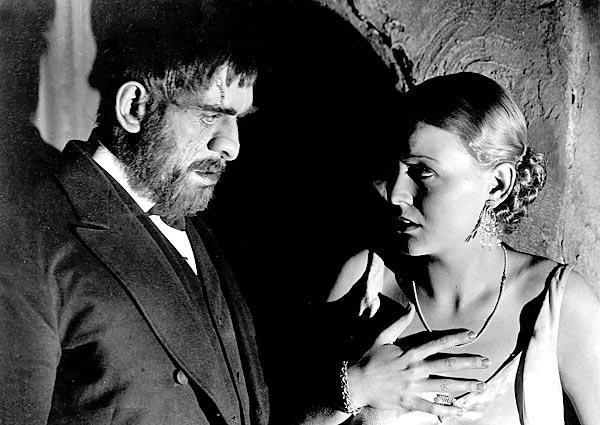Top 5 – Halloween Movies (Part 2)
4) The Old Dark House, 1932, directed by James Whale, starring Boris Karloff, Melvyn Douglas, Charles Laughton, Gloria Stuart, Ernest Thesiger, Raymond Massey, and Elspeth Dudgeon
The most acclaimed horror films from the early days of sound were those produced by Universal Pictures in the early 1930’s: Frankenstein, Dracula, The Mummy, The Invisible Man, and The Bride of Frankenstein . Even those who have never seen them have images from these films haunting their subconscious. Three of these titles were directed by James Whale, but one of the most memorable in the series also directed by Whale is not nearly as well known, the 1932 dark comedy The Old Dark House, based on a novel by J. B. Priestley.
. Even those who have never seen them have images from these films haunting their subconscious. Three of these titles were directed by James Whale, but one of the most memorable in the series also directed by Whale is not nearly as well known, the 1932 dark comedy The Old Dark House, based on a novel by J. B. Priestley.
Like many dark comedies, some viewers don’t “get it”. The movie did poorly at the American box office upon its initial release, in spite of a publicity campaign that sought to capitalize on Boris Karloff’s success in Frankenstein the previous year. In England, however, the film was a smash hit. For many years, however, all copies of the movie disappeared, and it was thought for decades to be a lost film. In the 1960’s, one of James Whale’s director friends nagged Universal Studios to seek out the lost elements, and convinced the George Eastman House to restore the film in 1968. Since then, in the words of Karl Williams of the Allmovie Guide, it has attained “grail-like status”.
The story takes place in the Welsh countryside, beginning as in many classic “old dark house” movies with a group of travelers seeking shelter from a storm in a gloomy house. Among the travelers are actors Melvyn Douglas and Charles Laughton, future Oscar winners, and Raymond Massey, a future Oscar nominee. Massey’s wife is portrayed by Gloria Stuart, who would become the oldest Oscar nominee in history sixty-five years later for Titanic. With such a talented cast, you would think they would be the focus of the film, and indeed there is enough back story and plot twists among them to make an entirely separate movie.
But the real stars of the film are the bizarre family by the name of Femm who live in the house. That’s right, Femm. If ever a film had a gay subtext, it’s this one. (Director James Whale was openly gay at a time when that was rare in Hollywood.) Horace Femm is dour and anxious. His memorable line, delivered deadpan with outstretched fork, is “Have a potato.” There is talk of the mysterious death of a sister, and we are left to wonder how. Horace’s sister Rebecca Femm is a fire and brimstone religious fanatic. When attractive Gloria Stuart strips to her slip in her bedroom, Rebecca chastises her for the sinful sexuality of her young body. (“Your silk gown will rot, and your body will rot too!”) And as if to emphasize the point she pokes her between the breasts (even in the days before the Production Code, this scene could only be done in silhouette), and in case we missed it, Stuart calls her out for the violation. Boris Karloff plays the drunken butler Morgan, who more overtly pursues the scantily clad Ms. Stuart. As we ascend to the upper floors of the house, we meet the bedridden patriarch of the family, 102 year old Sir Roderick Femm, who is portrayed by the sixty-year old actress Elspeth Dudgeon (listed in the credits as “John Dudgeon”), in a truly Dickensian performance. Indeed, it seems that each new floor in the house brings a heightened level of weirdness.
But one thing every family member agrees upon is that the most dangerous person in the family is Horace and Rebecca’s brother Saul, who must always be kept under lock and key. The joke is that, when we finally meet Saul (minor spoiler alert), he seems to be the most normal member of the family. But maybe not.
This is not the old dark house so frequently seen in ghost stories, with looming Victorian architecture, ornate wood carvings, and shiny mahogany. (RKO had a stairway set that was reused from film to film, and seemed to haunt us just by standing there.) I often wonder if I am missing something due to diminished print quality over the years, because The Old Dark House seems as if it were filmed in a dark closet with an invisible elevator, the better to see those incredible faces. A truly strange film.

5) The Texas Chainsaw Massacre, 1974, directed by Tobe Hooper, starring Marilyn Burns, Gunnar Hansen, and Edwin Burns
I resisted seeing this movie for years. I recall seeing the television promo when the film was new. There were barely any visuals; if memory serves only a split second shot of a shadowy hand lifting the saw, followed by a black screen, the sound of a chainsaw, and an ominous announcer intoning the title. My reaction was, “Yuck!”
In the early 1980’s, after buying my first VCR and renting movies several times a week, a clerk at a local video store, who himself was an aspiring filmmaker, kept coaxing me to watch The Texas Chainsaw Massacre, which he contended was a cinematic masterpiece. Finally one night I capitulated, and got myself in the mood for “an evening of gore”. The truth is, the film is barely gory at all. Macabre yes, but gory no. Tim Burton’s Sweeney Todd is infinitely gorier. You never once see a chainsaw tearing flesh or drawing blood. But the film is scary as hell. If you’re in the mood to have the pants scared off you, I highly recommend this movie.
The film is actually a dark comedy about a three generation family of slaughterhouse workers who can’t break their old habits after their local business closes. Four teenagers have the misfortune to get lost and happen upon their surreal house. The first half of the film we follow the young people and observe how obnoxious and irritating they are. The second half, well you can imagine.
The Texas Chainsaw Massacre is one of three films with the dubious distinction of creating the template for the modern horror film, in particular the “slasher” movie. (The other two are Night of the Living Dead (1968) and Halloween (1978).) All three of them are less gruesome than the films they influenced, and all three have their own unique cult film status. Tobe Hooper would be tapped by producer Steven Spielberg to direct a more family oriented horror classic, Poltergeist (1982), in which the melding of humor and ever accelerating terror is worthy of the creator of Leatherface and his clan.

And I promised my wife to include a favorite film of hers as a bonus:
The Uninvited, 1944, directed by Lewis Stone, starring Ray Milland, Ruth Hussey, Donald Crisp, Gail Russell, and Alan Napier
Once again, we are in an old dark house, this time on the rocky coast of England, with Milland and Hussey playing a brother and sister, who think this will be an ideal spot for brother to pursue his career as a composer. Very quickly they sense that they are not alone, and the townspeople confirm their suspicions that there is a spirit within the house that will not rest until its earthly cares are resolved.
There’s an endangered maiden, a father in denial about his past, and characters who are not what they appear to be. And I guess I have to admit to a gay subtext here as well, in a character obviously influenced by Mrs. Danvers in Alfred Hitchcock’s Rebecca, who has an unhealthy obsession with a dead woman. And like the film noir Laura, it even originated an American pop standard, this one Victor Young’s “Stella by Starlight”.
And that’s all I’m going to tell you. Watch this movie if you want to see an old fashioned ghost story without a whiff of gore or violence, but plenty of spookiness and romance, terrific performances, and a great plot twist at the end.

Happy Halloween.
Tags:Halloween, movies, top5





